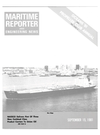
Page 3: of Maritime Reporter Magazine (September 15, 1981)
Read this page in Pdf, Flash or Html5 edition of September 15, 1981 Maritime Reporter Magazine
Two Vessels Trucked To 'Sea'
The 36-foot long towboat Arctic Falcon, her detached pilothouse at the rear, begins a six-day voyage by flatbed trailer truck via the Alcan Highway to Prudhoe
Bay, Alaska. The vessel was specifically designed to be hauled by truck.
Two recently delivered vessels—a vehicle ferry and a harbor push tug—had to endure difficult overland journeys by truck to reach the sites of their respective intended service.
The Arctic Falcon is a 36-foot-long tow- boat that was specifically designed to be trucked overland. The vessel was delivered by Columbia Marine Construction, Inc., Van- couver, Wash., to Knappten Corporation,
Portland, Ore.
Upon completion, which took a little more than six weeks from the time the order was received, the vessel was transported by truck on a six-day trip to Prudhoe Bay over the Alcan Highway. For such moves, the fully-insulated pilothouse can be removed in about 20 minutes with the use of hand tools. The two-piece vessel and house then are loaded onto a standard 45-foot flatbed truck for transport without convoy along roads with a maximum 14-foot-height re- striction. The tug was in service the day after she arrived.
The Arctic Falcon is the first in a series of small truckable tugs called Harbormates that range in size from 24 feet 11 inches to 35 feet 11 inches. Columbia Marine builds the tugs under license to a design of
Penobscot Marine of Tacoma.
Specially tailored by Knappton for Arctic operations, the vessel is powered by twin
Cummins NT-855M diesel engines through
Twin Disc MG 509 3:1 gears and is capable of a maximum speed of five knots pulling and eight knots pushing. With the Cum- mins fuel-efficient engines, the 1,000-gallon fuel tank provides more than 50 hours' en- durance. Hough-Wagner M24 hydraulic steer- ing and Wagner propulsion controls, with port and starboard jog stations, provide pos- itive control through the twin 38-inch stain- less-steel, four-blade propellers. A modified tunnel stern with anticavitation design al- lows the maximum use of the horsepower available. A full package of electronics and navigational equipment make the vessel ideal for offshore to harbor use.
A new ferry, Columbian Princess, built by Fishermen's Boat Shop, Everett, Wash., recently made a long journey by water and 108 miles overland by truck to Lake Roose- velt on the backwaters of the Grand Coulee
Dam in eastern Washington. Built for the
Bureau of Indian Affairs, the vehicle ferry was delivered to the Colville Confederated
Tribes who will operate it on Lake Roosevelt.
The Columbian Princess will be the new
Inchelium-Gifford free ferry used to handle expanding local traffic including logging and mining trucks in that area as well as gen- eral public vacationing traffic, particularly during the summer.
The vessel is unique in construction. There are four General Motors diesel 4-71 engines, one in each corner powering outdrive units with 36-inch propellers that can rotate the ship 360 degrees. The engines are controlled from a central pilothouse and usually are run in pairs, though they have the capability of operating separately, providing the ferry with extreme maneuverability. It will hold 16 vehicles up to 15 feet 7 inches in height, and the hydraulic ramps on each and facil- itate loading.
From Everett, the 42-foot-wide, 120-foot- long ferry proceeded under her own power through the Strait of Juan de Fuca to the
Pacific Ocean and down the coast to the mouth of the Columbia River, then up the
Columbia, passing through the locks of five dams. At Burbank, near Pasco, it had the ramps, propulsion units and superstructure removed, then was towed to Lower Monu- mental Dam on the Snake River. There the 170-ton hull was taken out of the water and put on heavy moving trucks. The Columbian
Princess was hauled 108 miles over country roads and state highways to Lake Roosevelt, passing wheatfields that had been sprinkled by Mount St. Helen's volcanic ash. This was
The Columbian Princess during sea trials in Everett. the widest load ever moved along Washing- ton state highways according to the state's
Department of Transportation. Five miles of road were widened and four bridges re- inforced for the 'voyage.' A crew preceded the ferry removing traffic signs and replac- ing them after the ferry had passed.
No matter how you look at it, complete lighterage and towing service...from one source...is always faster, easier and more efficient...for you.
Gillen has earned an enviable reputation as the company with the full experience and diversified equipment vital for the more-than-satisfactory execution of any lighterage assignment since 1865.
Henry Mien's Sons m LIGHTERAGE. INC. 21 WEST MAIN ST., OYSTER BAY, NEW YORK, N.Y. 11771 • 24 HOUR SERVICE (212) 895-8110
COASTWISE TOWING • BARGING • LIGHTERAGE
TUGS • BARGES • FLOATING CRANES
PICTURE THE
ADVANTAGES OF
COMPLETE f LIGHTERAGE
SERVICE
September 15, 1981 Write 292 on Reader Service Card 5

 2
2

 4
4
